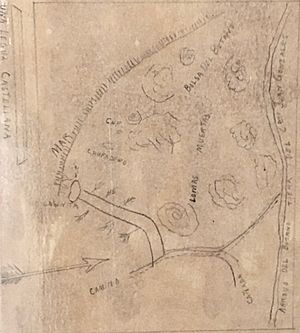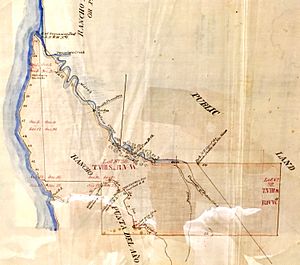Rancho Butano facts for kids
Rancho Butano was a large piece of land, about 4,439 acres (18 square kilometers), given as a Mexican land grant in what is now San Mateo County, California. In 1838, Governor Juan Alvarado first granted it to Ramona Sanchez. Governor Manuel Micheltorena confirmed this grant in 1844.
The name "Butano" might come from a word for a drinking cup made from a bull's horn, which was called a butano by Californios (people of Mexican heritage living in California). It's also possible the name came from a Native American language, but this isn't confirmed.
At first, the rancho was part of Santa Cruz County from 1850 to 1868. Later, the county line was changed, and the land became part of San Mateo County. The rancho stretched along the Pacific coast. It was located between Rancho Pescadero and Rancho Punta del Año Nuevo. Butano Creek was to the north, and Arroyo de los Frijoles (Creek of the Beans) was to the south. Today, this area includes Bean Hollow State Beach and Butano State Park.
Contents
History of Rancho Butano
During Mexican rule, California society began to change a lot. The large mission lands, which had been controlled by the missions, started to be divided up. Many settlers asked for land grants. Between 1834 and 1836, the Mexican government gave away millions of acres of former mission lands to private owners. When the missions no longer controlled the land, the original inhabitants (Native Americans) no longer had their claims to it recognized in the same way.
The former cattle ranches at Pescadero and Año Nuevo, which belonged to the missions, were eventually split into three separate land grants for Mexican citizens. These new land divisions included Rancho San Antonio (or Pescadero), Rancho Punta del Año Nuevo, and Rancho Butano.
Early Owners and Transfers
Juan Venancio Galindo married María Ramona Lorenza Sanchez in 1795. Their son, José Antonio Galindo, received two other land grants in 1835. The Butano Rancho, which was about one square league (a large area of land), was granted to Ramona Sanchez. She was the widow of Venancio Galindo. This happened in 1838, and it was the first grant given by Governor Juan Alvarado. Governor Manuel Micheltorena re-granted the land to her in 1844. In 1852, Ramona Sanchez sold Rancho Butano to Manuel Rodriguez.
Changes After the Mexican-American War
After the Mexican-American War, California became part of the United States. The 1848 Treaty of Guadalupe Hidalgo stated that the existing Mexican land grants would be respected. The Public Land Commission was set up to check these land claims. Manuel Rodríguez filed a claim for Rancho Butano in 1853. He won a disagreement about the northern border with Rancho Pescadero in 1863. The grant was officially given to Manuel Rodríguez in 1866.
Later Owners and Development
In 1862, Rancho Butano was sold to Clark & Coburn, a company from San Francisco. Loren Coburn, who was born in Vermont, came to California in 1851 and first worked in mining. He later bought out his brother-in-law, Jeremiah Clark. Coburn also bought Rancho Punta del Año Nuevo, which was just to the south. He was very determined about his land, often going to court to settle disagreements about property lines.
In the 1890s, Coburn built a large hotel on the cliffs above Pebble Beach. He hoped it would become a popular place for vacationers who would use the planned Ocean Shore Railroad from San Francisco. At that time, Pescadero Marsh was not very important to Mr. Coburn. There were no official roads through it, and cattle grazed freely because it was not fenced.
The San Francisco earthquake in 1906 stopped the construction of the railroad, and the hotel closed permanently. Coburn leased much of his land to the Steele family (Rensselaer, Isaac, and Edgar), who ran a dairy farm. Coburn and Clark's strong efforts to protect their land slowed down the process of dividing and developing Rancho Butano. Loren Coburn passed away on November 14, 1918, at the age of ninety-two. By 1920, Coburn’s land near Pescadero was divided into smaller farms by the Peninsula Farms Company. This company had bought the land rights from one of Coburn’s trustees, Mr. Christopher Wideman. Similarly, Butano Farms also became an agricultural area.



